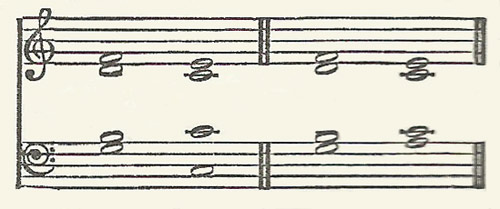dominant

The dominant is the fifth degree of a major or minor (diatonic) scale; it lies a
perfect fifth above the tonic. It is called
dominant because it is next in order of importance to the tonic.
A dominant chord is any chord built on the dominant. For example in the scale of C major, the dominant
is the note G and the dominant chord is v G-B-D. Within a major scale, the dominant triad is a major chord symbolized by the Roman
numeral V. Within a minor scale, the dominant triad is a minor chord symbolized
by v. For example in the case of C minor, the dominant triad is G-B♯-D.
In a minor scale, the dominant triad is often substituted with a major triad,
by sharpening the second note, which is a minor third from the dominant
note, into a major third, since the major third from the dominant is the
leading tone for the minor scale. For instance, in G-B♯-D, the B♯
is sharpened to B natural, since B natural is the leading tone for the C
minor scale.
A dominant seventh chord is a chord built upon the dominant of a major diatonic scale, containing a dominant (major) triad and an additional minor seventh (for example G-B-D-F in C major). It is typically denoted G7. The dominant seventh normally resolves on the tonic or submediant chord, the note constituting the seventh falling a semitone.
See also secondary dominant.
The dominant key in tonal modulation
"Dominant" also refers to a relationship of musical keys. For example, relative to the key of C major, the key of G major is the dominant key. Music which modulates (changes key) often modulates into the dominant. Modulation into the dominant key often creates a sense of increased tension; as opposed to modulation into the subdominant (fourth note of the scale), which creates a sense of musical relaxation.
For dominant cadence, see cadence.


